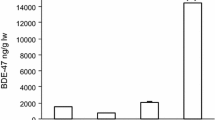Abstract
Hexanitrohexaazaisowurtzitane, or CL-20, is an emerging highly energetic compound currently under consideration for military applications. With the anticipated wide use of CL-20, there is the potential for soil and groundwater contamination resulting in adverse toxicologic effects on environmental receptors. Presently, there is a lack of data describing the toxic effects of CL-20 on avian species. The present study describes the effect of CL-20 on Japanese quail (Coturnix coturnix japonica) modified from standard toxicity test guidelines. First, a 14-day subacute assay was adopted using repeated gavage doses (0, 307, 964, 2439, 3475, or 5304 mg CL-20/kg body weight (BW)/d for 5 days followed by no CL-20 exposure (vehicle only) for 10 days. Second, a subchronic feeding assay (0, 11, 114, or 1085 mg CL-20/kg feed) was done for 42 days. During both studies, no overt toxicity was observed in the CL-20–treated birds. During the first 5 days of the subacute study, CL-20–exposed birds showed a dose-dependent decrease in BW gain, whereas increased liver weight, plasma sodium, and creatinine levels were observed in birds receiving the highest dose tested. For the subchronic study, embryo weights were significantly decreased in a dose-dependent manner. Embryos from CL-20–exposed birds were observed to have multiple cranial and facial deformities, beak curvatures, possible mid-brain enlargement, and classic one-sided development with micro-opthalamia (nonstatistical comparisons with control embryos). A trend toward decreased number of eggs laid per female bird was also observed. We conclude that CL-20 (or its degradation products) elicits few effects in adults but may affect avian development, although these preliminary findings should be confirmed.








Similar content being viewed by others
References
InstitutionalAuthorNameASTM (1997) Standard practice for conducting subacute dietary toxicity tests with avian species American Society for Testing and Materials West Conshohocken, PA
B Bhushan A Halasz J Hawari (2004a) ArticleTitleNitroreductase catalyzed biotransformation of CL-20 Biochem Biophys Res Commun 322 271–276 Occurrence Handle10.1016/j.bbrc.2004.07.115
B Bhushan A Halasz JC Spain J Hawari (2004b) ArticleTitleInitial reaction(s) in biotransformation of CL-20 is catalyzed by salicylate 1-monooxygenase from Pseudomonas sp Strain ATCC 29352. Appl Environ Microbiol 70 4040–4047 Occurrence Handle10.1128/AEM.70.7.4040-4047.2004
Canadian Council on Animal Care (1984) Japanese quail. In: Guide to the care and use of experimental animals. Available at: http://www.ccac.ca/en/CCAC_programs/Guidelines_Policies/GUIDES/ENGLISH/TOC_V2.htm. Accessed: 11 April 2005
M Geetha UR Nair DB Sarwade GM Gore SN Asthana H Singh (2003) ArticleTitleStudies on CL-20: The most powerful high energy material J Therm Anal Cal 73 913–922 Occurrence Handle10.1023/A:1025859203860
RM Gogal MS Johnson CT Larsen MR Prater RB Duncan DL Ward et al. (2003) ArticleTitleDietary oral exposure to 1,3,5-trinitro-1,3,5-triazine in the northern bobwhite (Colinus virginianus) Environ Toxicol Chem 22 381–387 Occurrence Handle10.1897/1551-5028(2003)022<0381:DOETTT>2.0.CO;2 Occurrence Handle12558171
P Gong GI Sunahara S Rocheleau SG Dodard PY Robidoux J Hawari (2004) ArticleTitlePreliminary ecotoxicological characterization of a new energetic substance, CL-20 Chemosphere 56 653–658 Occurrence Handle10.1016/j.chemosphere.2004.04.010 Occurrence Handle15234161
Z Gregus JB Watkins TN Thompson MJ Harvey K Rozman CD Klaassen (1983) ArticleTitleHepatic phase I and phase II biotransformations in quail and trout: Comparison to other species commonly used in toxicity testing Toxicol Appl Pharmacol 67 430–441 Occurrence Handle10.1016/0041-008X(83)90327-7 Occurrence Handle6845369
V Hamburger HL Hamilton (1951) ArticleTitleA series of normal stages in the development of the chick embryo J Morphol 88 49–92 Occurrence Handle10.1002/jmor.1050880104
MS Johnson HI Paulus CJ Salice RT Checkai M Simini (2004) ArticleTitleToxicologic and histopathologic response of the terrestrial salamander Phethodon cinereus to soil exposure of 1,3,5-trinitrohexahydro-1,3,5-triazine Arch Environ Contam Toxicol 47 496–501 Occurrence Handle10.1007/s00244-004-3242-7 Occurrence Handle15499500
BS Levine EM Furedi DE Gordon JM Burns PM Lish (1981) ArticleTitleThirteen-week toxicity study of hexahydro-1,3,5-trinitro-1,3,5-triazine (RDX) in Fischer 344 rats Toxicol Lett 8 241–245 Occurrence Handle10.1016/0378-4274(81)90108-9 Occurrence Handle7196606
F Monteil-Rivera L Paquet S Deschamps VK Balakrishnan C Beaulieu J Hawari (2004) ArticleTitlePhysico-chemical measurements of CL-20 for environmental applications: Comparison with RDX and HMX J Chromatogr A 1025 125–132 Occurrence Handle10.1016/j.chroma.2003.08.060 Occurrence Handle14753679
AT Nielsen AP Chafin SL Christian DW Moore MP Nadler RA Nissan et al. (1998) ArticleTitleSynthesis of polyazapolycyclic caged polynitramines Tetrahedron 54 11793–11812
InstitutionalAuthorNameOECD (1984a) OECD guidelines for testing of chemicals. Avian dietary toxicity test Organization for Economic Cooperation and Development Paris, France
InstitutionalAuthorNameOECD (1984b) OECD guidelines for testing of chemicals. Avian reproduction test Organization for Economic Cooperation and Development Paris, France
PY Robidoux GI Sunahara K Savard Y Berthelot S Dodard M, Martel et al. (2004) ArticleTitleAcute and chronic toxicity of the new explosive CL-20 to the earthworm (Eisenia andrei) exposed to amended natural soils Environ Toxicol Chem 23 1026–1034 Occurrence Handle10.1897/03-308 Occurrence Handle15095901
NR Schneider SL Bradley ME Andersen (1976) Toxicology of cyclotrimethylene-trinitramine (RDX): Distribution and metabolism in the rat and miniature swine AFRRI SR76-34. Armed Forces Radiobiology Research Institute Bethesda, MD
SS Talmage DM Opresko CJE Maxwell JE Welsh FM Cretella PH, Reno et al. (1999) ArticleTitleNitroaromatic munition compounds: Environmental effects and screening values Rev Environ Contam Toxicol 161 1–156 Occurrence Handle10218448
USEPA (1996a) Avian dietary toxicity tests ecological effects guidelines. EPA 712/C/96/140. United States Environmental Protection Agency
USEPA (1996b) Avian reproduction test ecological effects guidelines. EPA 712/C/96/141. United States Environmental Protection Agency
USEPA (1998) Nitroaromatics and nitramines by high performance liquid chromatography (HPLC)—Method 8330A. In: Test methods for evaluating solid waste, physical/chemical methods. SW-846 update III, part 4:1 (B). United States Environmental Protection Agency Office of Solid Waste
Acknowledgments
We thank Fanny Monteil-Rivera and Mark S. Johnson for their review of an earlier version of the manuscript. In addition, we thank Manon Sarrazin, Sabine Dodard, and Louise Paquet from Biotechnology Research Institute (National Research Council of Canada) for their technical assistance; the United States Strategic Environmental Research and Development Program (SERDP Project No. CP1256) for financial support; and Thiokol Propulsion Inc. for providing the ε-CL-20. This article was assigned NRC publication 47222.
Author information
Authors and Affiliations
Corresponding author
Rights and permissions
About this article
Cite this article
Bardai, G., Sunahara, G.I., Spear, P.A. et al. Effects of Dietary Administration of CL-20 on Japanese QuailCoturnix coturnix japonica. Arch Environ Contam Toxicol 49, 215–222 (2005). https://doi.org/10.1007/s00244-004-0231-9
Received:
Accepted:
Published:
Issue Date:
DOI: https://doi.org/10.1007/s00244-004-0231-9




